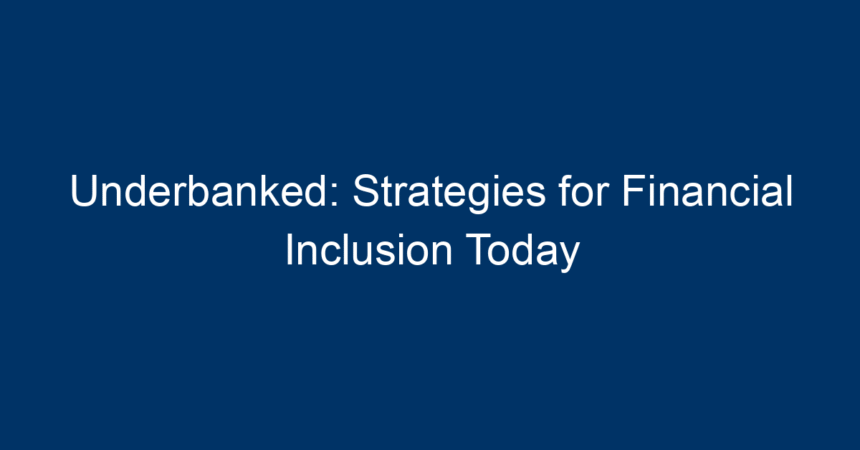In today’s world, where financial transactions can often happen with a tap on a smartphone, the term "underbanked" refers to a significant population that struggles to access traditional banking services. These individuals are often excluded from mainstream finance, limiting their ability to manage money effectively. In this article, we will explore the characteristics of the underbanked population, the implications of financial exclusion, and actionable strategies aimed at promoting financial inclusion.
Understanding the Underbanked
Defining the Underbanked
The underbanked are individuals who have access to some financial services but still rely heavily on alternative financial products such as payday loans, check-cashing services, or prepaid debit cards. Unlike the unbanked, who completely lack access to any banking services, the underbanked may have a bank account but face obstacles that prevent them from fully utilizing traditional banking.
Key Statistics
According to recent data from the Federal Reserve, approximately 20% of Americans are considered underbanked. This statistic highlights a critical need for more comprehensive financial solutions that can support their needs. The underbanked often find themselves paying higher fees for basic financial services, which can lead to a cycle of debt.
The Causes of Underbanking
Several factors contribute to the underbanked status of individuals, including lower income levels, lack of education in financial literacy, geographic remoteness, and discrimination. In many cases, these individuals reside in areas without access to physical bank branches or lack the necessary documentation to open an account.
The Importance of Financial Inclusion
The Economic Impact
Financial exclusion has far-reaching economic implications not just for individuals but for communities and economies as a whole. When people cannot access affordable financial services, they may turn to predatory lending or high-fee alternatives that perpetuate cycles of poverty.
Building Stronger Communities
Financial inclusion is more than just a moral imperative; it fosters community development. When individuals gain access to fair financial products, they can save and invest in their futures, leading to healthier economies. Research has shown that financially included individuals contribute positively to their communities by generating economic growth and reducing reliance on social services.
Strategies for Promoting Financial Inclusion
1. Increasing Financial Literacy
One of the most effective ways to assist the underbanked is through financial literacy programs. Education is crucial for empowering individuals to make informed financial decisions. Here’s how to implement successful financial literacy initiatives:
- Workshops and Seminars: Community organizations and local banks can hold educational sessions covering budgeting, saving, and accessing credit.
- Online Resources: Create a user-friendly online platform that offers accessible financial education materials, including videos and infographics.
2. Expanding Access to Banking Services
To address the barriers faced by the underbanked, it’s essential to expand access to traditional banking services. Here are some approaches:
- Mobile Banking Solutions: Banks should develop user-friendly mobile apps that allow for easy access to basic banking services, especially in remote areas.
- Community Bank Partnerships: Collaborate with community banks to establish branches in underserved areas. These banks can provide services tailored to the unique needs of the underbanked.
3. Utilizing Technology for Financial Inclusion
Fintech companies have emerged as a driving force in improving access to financial services for underbanked individuals. Here’s how technology can help:
- Digital wallets: Platforms like PayPal and Venmo offer consumers an easy way to pay bills and send money without the need for a traditional bank account.
- Peer-to-Peer Lending: These platforms can offer loans to individuals who may not qualify for traditional loans, often at lower interest rates.
4. Creating Low-Cost Financial Products
Traditional banking products can be cost-prohibitive for underbanked individuals. Financial institutions should create low-cost or no-cost offerings:
- Basic Checking Accounts: Offer low-fee or no-fee checking accounts with no minimum balance requirements.
- Prepaid Debit Cards: Develop prepaid debit cards that come with fewer fees and more acceptable terms than those currently prevalent in the market.
5. Engaging Community Organizations
Community organizations often have intimate knowledge of the needs of underbanked individuals. Partnering with them can facilitate better outreach and service delivery:
- Local Outreach Programs: Collaborate with non-profits to reach underbanked populations through targeted initiatives.
- Co-sponsored Events: Joint events can increase awareness of financial products available to the underbanked.
Policy Recommendations for Financial Inclusion
Government Initiatives
Governments can play a significant role in enhancing financial inclusion. Here are some policy options:
- Regulations Favoring Financial Inclusion: Implement regulations that encourage banks to reach underserved communities.
- Tax Incentives: Provide tax breaks for financial institutions that offer services to the underbanked population.
Financial Institutions
Banks and credit unions should also take proactive measures:
- Training Staff: Ensure frontline staff receive training to identify and serve underbanked individuals effectively.
- Diversifying Product Offerings: Innovate and diversify products to better meet the needs of underbanked customers.
Conclusion: Path to Financial Inclusion
The underbanked represent a considerable portion of the population facing barriers to full financial participation. Addressing their needs through targeted strategies can lead to a more equitable and thriving society. By increasing financial literacy, expanding access to banking services, employing innovative technology, and fostering community partnerships, we can create a roadmap towards financial inclusion for all.
Actionable Insights
As individuals, we can contribute to these efforts by advocating for policies that promote financial inclusion, supporting community-based organizations, and sharing valuable resources with those who may benefit. Financial inclusion isn’t just a personal benefit; it’s a community responsibility that can lead us toward a brighter, more equitable future.
By investing time and resources into uplifting the underbanked, we not only enhance their lives but also build stronger, more resilient communities that thrive in the global economy. The journey towards financial inclusion is ongoing, but with concerted effort, we can create impact that lasts.




